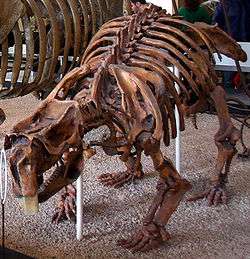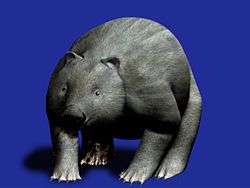Phascolonus
| Phascolonus | |
|---|---|
 | |
| Phascolonus | |
| Scientific classification | |
| Kingdom: | Animalia |
| Phylum: | Chordata |
| Class: | Mammalia |
| Infraclass: | Marsupialia |
| Order: | Diprotodontia |
| Suborder: | Vombatiformes |
| Family: | Vombatidae |
| Genus: | †Phascolonus Owen, 1872 |
| Species | |
| |
Phascolonus was a genus of prehistoric Australian marsupials in the wombat family. The largest species, Phascolonus gigas, weighed as much as 200 kg (450 lb).[2] Phascolonus existed alongside an even larger marsupial, Diprotodon, which weighed as much as three tons and was distantly related to wombats.[3] Both disappeared at the end of the Late Pleistocene in a Quaternary extinction event together with many other large Australian animals.

Phascolonus
At Tea Tree Cave, a two-million-year-old Phascolonus fossil was found alongside that of the crocodilian Quinkana.[4]
References
- ↑ Mikko's Phylogeny Archive
- ↑ Long, J.; Archer, M.; Flannery, T.; Hand, S. (2002). Prehistoric Mammals of Australia and New Guinea: One Hundred Million Years of Evolution. University of New South Wales Press. pp. 161–162. ISBN 978-0-8018-7223-5. OCLC 49860159.
- ↑ Museum Victoria [ed-online] Dinosaurs & Fossils - The rise of the modern fauna and flora
- ↑ Chillagoe Interpretive Centre
This article is issued from Wikipedia - version of the 10/16/2016. The text is available under the Creative Commons Attribution/Share Alike but additional terms may apply for the media files.